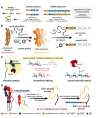Excavating proteoglycan structure-function relationships: modern approaches to capture the interactions of ancient biomolecules
- PMID: 35759439
- PMCID: PMC9359657
- DOI: 10.1152/ajpcell.00222.2022
Excavating proteoglycan structure-function relationships: modern approaches to capture the interactions of ancient biomolecules
Abstract
Proteoglycans are now well regarded as key facilitators of cell biology. Although a majority of their interactions and functions are attributed to the decorating glycosaminoglycan chains, there is a growing appreciation for the roles of the proteoglycan core protein and for considering proteoglycans as replete protein-glycan conjugates. This appreciation, seeded by early work in proteoglycan biology, is now being advanced and exalted by modern approaches in chemical glycobiology. In this review, we discuss up-and-coming methods to unearth the fine-scale architecture of proteoglycans that modulate their functions and interactions. Crucial to these efforts is the production of chemically defined materials, including semisynthetic proteoglycans and the in situ capture of interacting proteins. Together, the integration of chemical biology approaches promises to expedite the dissection of the structural heterogeneity of proteoglycans and deliver refined insight into their functions.
Keywords: chemical biology; glycobiology; glycosaminoglycans; interactome; proteoglycan.
Conflict of interest statement
No conflicts of interest, financial or otherwise, are declared by the authors.
This article is part of the special collection “Deciphering the Role of Proteoglycans and Glycosaminoglycans in Health and Disease.” Liliana Schaefer, MD, served as Guest Editor of this collection.
Figures



Similar articles
-
Chemical editing of proteoglycan architecture.Nat Chem Biol. 2022 Jun;18(6):634-642. doi: 10.1038/s41589-022-01023-5. Epub 2022 May 12. Nat Chem Biol. 2022. PMID: 35551261 Free PMC article.
-
Neoproteoglycans in tissue engineering.FEBS J. 2013 May;280(10):2511-22. doi: 10.1111/febs.12187. Epub 2013 Mar 7. FEBS J. 2013. PMID: 23399318 Free PMC article. Review.
-
Differentially expressed patterns of glycosaminoglycan structure in heparan sulfate proteoglycans and free chains.Eur J Biochem. 1993 Feb 1;211(3):771-9. doi: 10.1111/j.1432-1033.1993.tb17608.x. Eur J Biochem. 1993. PMID: 8436134
-
Analysis of glycosaminoglycan chains from different proteoglycan populations in human embryonic skin fibroblasts.Eur J Biochem. 1992 Sep 1;208(2):537-46. doi: 10.1111/j.1432-1033.1992.tb17218.x. Eur J Biochem. 1992. PMID: 1521543
-
Proteoglycans and proteoglycan mimetics for tissue engineering.Am J Physiol Cell Physiol. 2022 Apr 1;322(4):C754-C761. doi: 10.1152/ajpcell.00442.2021. Epub 2022 Mar 2. Am J Physiol Cell Physiol. 2022. PMID: 35235426 Free PMC article. Review.
Cited by
-
Solid-Phase-Supported Chemoenzymatic Synthesis and Analysis of Chondroitin Sulfate Proteoglycan Glycopeptides.Angew Chem Int Ed Engl. 2024 Aug 19;63(34):e202405671. doi: 10.1002/anie.202405671. Epub 2024 Jul 11. Angew Chem Int Ed Engl. 2024. PMID: 38781001 Free PMC article.
-
Mapping the FGF2 Interactome Identifies a Functional Proteoglycan Coreceptor.ACS Chem Biol. 2025 Jan 17;20(1):105-116. doi: 10.1021/acschembio.4c00475. Epub 2024 Dec 20. ACS Chem Biol. 2025. PMID: 39704408 Free PMC article.
-
Global impact of proteoglycan science on human diseases.iScience. 2023 Oct 4;26(11):108095. doi: 10.1016/j.isci.2023.108095. eCollection 2023 Nov 17. iScience. 2023. PMID: 37867945 Free PMC article. Review.
-
The Evolution of Chemical Biology into Translational Physiology and Precision Medicine.Am J Physiol Cell Physiol. 2025 Jul 16:10.1152/ajpcell.00438.2025. doi: 10.1152/ajpcell.00438.2025. Online ahead of print. Am J Physiol Cell Physiol. 2025. PMID: 40668627 Free PMC article.
References
Publication types
MeSH terms
Substances
Grants and funding
- K99 HD090292/HD/NICHD NIH HHS/United States
- R00HD090292/HHS | NIH | Eunice Kennedy Shriver National Institute of Child Health and Human Development (NICHD)
- R35 GM142462/GM/NIGMS NIH HHS/United States
- R35GM142462/HHS | NIH | National Institute of General Medical Sciences (NIGMS)
- R00 HD090292/HD/NICHD NIH HHS/United States
LinkOut - more resources
Full Text Sources

